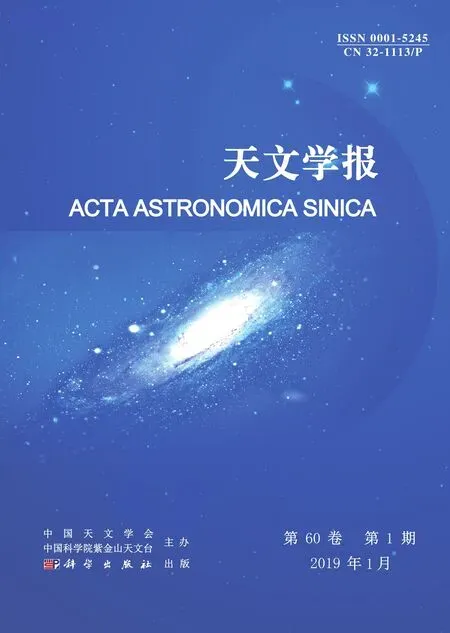高能中微子和极高能宇宙线起源天体的理论研究
2019-01-17柳若愚
柳若愚
(南京大学天文与空间科学学院 南京 210023)
极高能宇宙线一般指来自地外的能量高于1018电子伏特(eV)的高能质子与原子核,其起源的研究一直是高能天体物理和粒子天体物理领域的热点问题.近年随着一些大型探测器(如Pierre Auger天文台)的运行,极高能宇宙线的研究取得很大进展.然而由于极高能宇宙线事例相对较少及其在从源到地球传播过程中的复杂性(如与宇宙微波背景辐射以及磁场的作用),需要通过观测这些宇宙线在强子反应中产生的次级粒子(如中微子)来获得其起源的额外信息.最近,位于南极的IceCube中微子天文台探测到了54个能量分布在60 TeV–3 PeV内的中微子事例,开启了高能中微子天文学的新时代.在本文中,我们研究了高能中微子、极高能宇宙线的天体物理起源以及它们之间可能的联系.
首先,我们讨论了高能中微子与极高能宇宙线拥有共同起源的可能性.根据两者的观测流量,推断出极高能宇宙线源的能量产生率与强子反应效率需要满足一定的关系才能够同时产生高能中微子.根据该关系可以初步排除一些模型.然后,提出了恒星形成星系中的中等相对论性骇新星遗迹可以同时作为IceCube高能中微子的源与极高能宇宙线的源,并计算了在该情况下预期的中微子能谱.同时,预言如果高能中微子与极高能宇宙线有共同起源,IceCube将在10–20 yr内观测到10 PeV的中微子.
接着,我们深入讨论了伽玛射线暴是否可以作为观测到的高能中微子的源.我们首先修正了IceCube团队早期工作中对伽玛射线暴中微子流量的过高估计.然后使用蒙特卡洛模拟,基于观测的伽玛暴参数的统计分布以及经验关系,模拟出了1组伽玛暴样本,包括能触发仪器响应的“亮暴”与无法触发仪器响应的“暗暴”.在确保“亮暴”符合观测的基础上,得出了“暗暴”也无法产生IceCube观测到的高能中微子的结论,进一步排除了伽玛暴作为中微子起源的可能性.
此外,我们研究了极高能宇宙线在光子场和磁场中的传播.对于前者,着重计算了极高能宇宙线在星系际空间传播时与背景光子场的光致蜕变、光介子反应和Bethe-Heitler反应,并发现从骇新星遗迹产生的极高能宇宙线经传播后的能谱及化学组成可以与观测相符合.对于后者,针对Pierre Auger天文台发现的能量大于5.7×1019eV的宇宙线到达方向与邻近宇宙的质量分布有成协的趋势,通过模拟不同种类的宇宙线在银河系磁场中受到的偏折,并利用带电粒子在磁场中的路径只依赖于磁刚度的特性,根据Pierre Auger天文台对于极高能宇宙线化学成份的观测,对这些极高能宇宙线源的距离以及金属丰度做出了限制.
最后,根据激波的流体力学演化与电子的辐射机制,我们对伽玛暴GRB 090902B与GRB 130427A多波段余辉辐射的光变曲线进行拟合,研究了这两个伽玛暴的瞬时辐射及晚期高能光子的起源.在此研究中,我们得到这些伽玛暴产生的激波参数,从而获知它们加速粒子的能力.
Ultrahigh energy cosmic rays(UHECRs)are the extraterrestrial energetic particles with energy above 1018eV.Thanks to the operation of large UHECR detectors such as the Pierre Auger Observatory(PAO),our understanding on UHECRs has been significantly improved in the past decade.However,due to the rarity of events and the complexity in their propagation to Earth,there are still lots of puzzles on UHECRs to be studied.Hence,it is useful to extract some additional information from the observation on the secondary particles(such as neutrinos)which are generated in the propagation of UHECRs.Recently,IceCube neutrino observatory located in the Antarctic Pole has discovered 54 neutrino events with energy from 60 TeV to 3 PeV,opening a new era of neutrino astronomy.In this paper,we investigate the astrophysical origin of high-energy neutrinos and UHECRs,and the possible link between them.
We find that the high-energy neutrinos may possibly originate from the same sources of the UHECRs,and deduce that the energy production rate of the source and the neutrino production efficiency satisfy a certain relation.Based on the relation,some sources can be excluded.We propose semi-relativistic hypernova remnants in star-forming galaxies as the common sources of the UHECRs and the high-energy neutrinos detected by IceCube,and predict that the IceCube is able to observe one∼10 PeV neutrino event in 10–20 yr.
Gamma-ray burst(GRB)has been widely studied as the possible sources of high-energy neutrinos.We have first corrected the overestimation on the expected neutrino flux from GRBs obtained by the IceCube Collaboration.Furthermore,we perform a Monte-Carlo simulation to generate a complete sample of GRBs,consisting of both bright GRBs that can trigger the detector and dim GRBs that cannot.On the premise that the bright GRBs can reproduce the properties of observed GRBs,we find that the dim GRBs cannot explain the observed neutrino events,and exclude GRBs as the sources of high-energy neutrinos.
Next,we study the propagation of UHECRs,including the propagation in photon field and in magnetic field.By considering the photodisintegration,the photopion production,and the Bethe-Heitler process of UHECRs in their propagation in the intergalactic space,we obtain the spectrum of UHECRs coming from the hypernova remnants throughout the whole universe.The obtained spectrum and mass composition are consistent with observations.On the other hand,by simulating the propagation of UHECRs in the Galactic magnetic fields,and utilizing the fact that the trajectories of cosmic rays in magnetic field are only rigidity-dependent,we put constraints on the UHECR source distance and metallicity after jointly taking into account the chemical composition and distribution of arrival directions of the UHECRs observed by PAO.
Lastly,we model the multi-wavelength light curves of afterglows of GRB 090902B and GRB 130427A by computing the dynamic evolution of GRB outflows and radiation of accelerated electrons.The origin of high-energy prompt and extended emission is studied.
